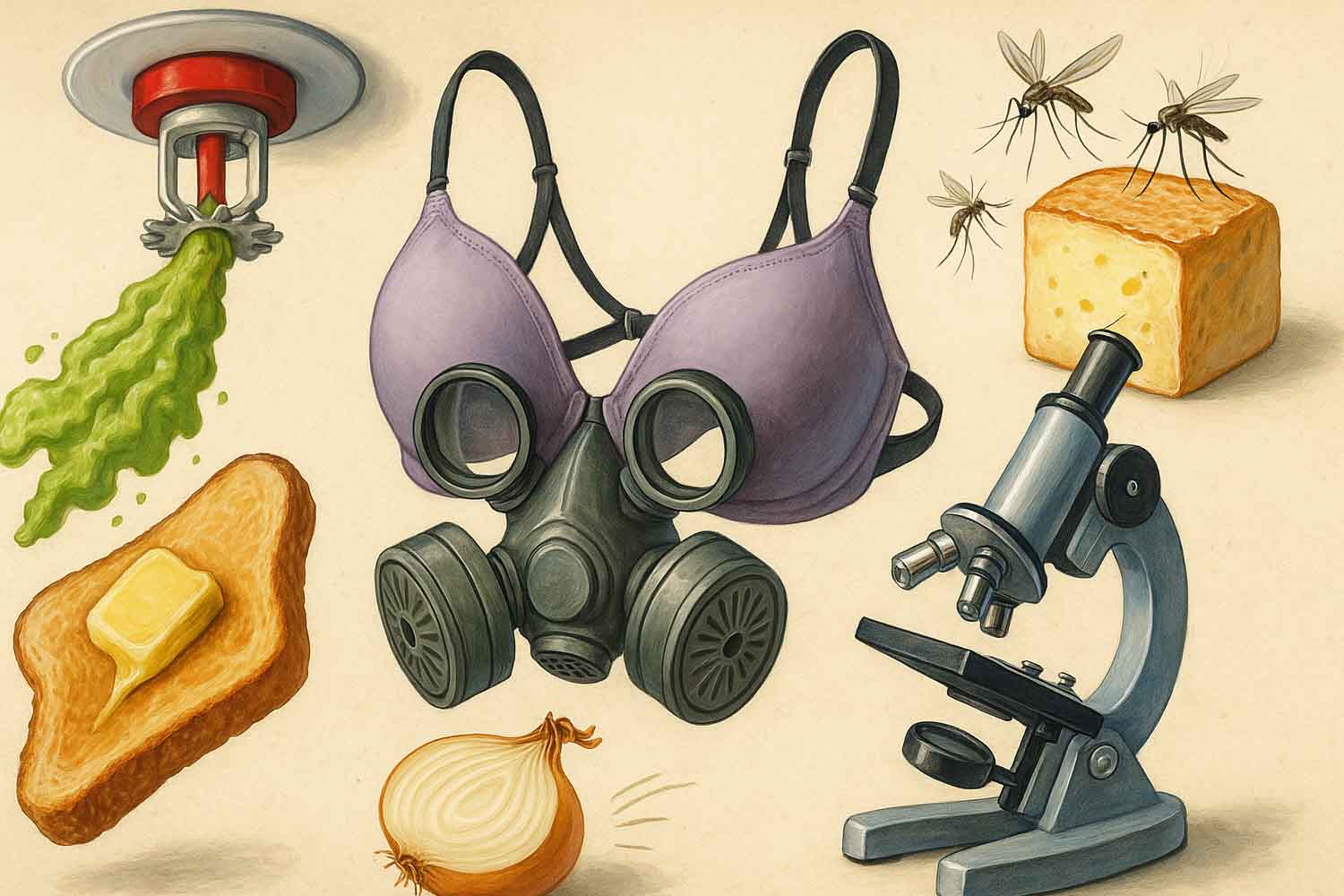From wasabi fire alarms to tearless onions, the Ig Nobel Prizes celebrate science that makes us laugh, then think. These quirky ideas reveal surprisingly practical insights.

Every year, there’s a global ceremony that honors the strangest, quirkiest, most eyebrow-raising scientific studies out there. No, it’s not the Nobel Prize. We’re talking about the Ig Nobel Prize, a tongue-in-cheek yet highly respected recognition for research so absurd it has to be true. These studies might make you laugh, but stick around—they’ll often make you think.
The fire alarm that smells like wasabi
In 2011, Japanese researchers Mayu Yamamoto and Makoto Imai developed a fire alarm that doesn’t buzz or beep. Instead, it emits a burst of wasabi gas—yes, that wasabi, the nasal-blasting green paste from sushi plates.
It wasn’t a joke or a culinary prank. This device was designed to help people with hearing loss wake up in emergencies. When triggered, it releases a dose of allyl isothiocyanate, a compound that activates the nasal passages with burning urgency, effectively jolting even the deepest sleeper. Not only did the alarm receive a patent and undergo trials in real assisted-living facilities, but it also sparked conversation about sensory substitution, where one sense compensates for another in urgent scenarios. It’s a smart twist on accessibility—and it kind of stings, too.
Why toast always lands butter-side down
You’ve probably dropped toast before. And if it was buttered, it almost certainly hit the floor that way. Pure bad luck? Not quite. In 1996, physicist Robert Matthews from Aston University decided to investigate. His conclusion: it’s physics, not fate.
The average table height simply doesn’t allow the toast enough airtime to complete a full rotation. So it lands—almost unfailingly—on its buttered face. This theory was even put to the test on MythBusters, with a toast-dropping machine that confirmed Matthews’ findings. A small problem, maybe, but it reveals how even life’s most mundane annoyances can hide elegant scientific truths.
The bra that becomes two gas masks
In the wake of the Chernobyl disaster, Ukrainian physician Elena Bodnar came up with an idea that sounds like a surreal prop from a sci-fi movie—but it’s real. She designed a bra that quickly converts into two gas masks: one for the wearer, and another for someone nearby.
It’s a clever design born out of urgency. In a catastrophe, seconds count. The ability to transform a common item of clothing into a protective device could, in theory, save lives. While it never reached the mass market, it was awarded a U.S. patent and earned Bodnar an Ig Nobel. Sometimes, genius is stitched into unexpected places.
Mosquitoes love stinky cheese
It might sound ridiculous, but malaria mosquitoes are attracted to Limburger cheese. Dutch biologist Bart Knols discovered that the cheese’s aroma closely mimics the scent of human foot sweat, an irresistible call for the disease-carrying insects.
Knols and his team took this one step further: they developed cheese-based mosquito traps. Female mosquitoes lay eggs in cheese-infused water, but the bacteria present kills the larvae. This cheap, sustainable solution is also being tested against other invasive species, like Drosophila suzukii, a fruit fly that wreaks havoc on Italian agriculture. From foul-smelling fromage to public health innovation, it’s a leap worth applauding.
Onions that don’t make you cry
No tears, just flavor. In 2013, Japanese chemists succeeded in isolating the enzyme responsible for triggering tears when onions are chopped. It’s called lachrymatory-factor synthase. By selectively breeding non-GMO onions, they developed a variety that doesn’t activate our tear ducts.
These “tearless onions” are now sold in several countries. But the impact goes beyond comfort in the kitchen. The research revealed deeper insights into plant defense mechanisms, with implications for future crop resilience. In short: fewer tears today, stronger agriculture tomorrow.
Vanilla from cow poop
Yes, you read that right. In 2007, Mayu Yamamoto (remember the wasabi alarm?) made headlines again by demonstrating how to extract vanillin—the molecule that gives vanilla its flavor—from cow feces.
Beyond the initial “ew” reaction, the idea has serious environmental potential. Using organic waste to synthesize useful compounds is a cornerstone of green chemistry, and Yamamoto’s work hinted at a more sustainable flavor industry. Sure, “cow-pat vanilla” may never become a supermarket hit, but the point stands: waste is just untapped opportunity in disguise.
A doctor performs a colonoscopy on himself
In 2006, Japanese gastroenterologist Akira Horiuchi took medical demonstration to an unprecedented level. He performed a self-colonoscopy, seated in a hospital chair, using only a pediatric scope and local anesthesia.
Why? To show that colorectal cancer screening doesn’t have to be terrifying. In Japan, fear and shame prevent many from undergoing this potentially life-saving exam. Horiuchi’s bold move, which earned him the 2018 Ig Nobel in Medical Education, wasn’t just stunt science. It was a statement—one that challenged taboos and sought to make medicine more approachable.
The deeper meaning behind the absurd
Ig Nobel-winning research can sound like a parody. But beneath the laughs, these ideas reveal something profound: a different way of looking at the world. Each study challenges assumptions, repurposes common objects, or uncovers truths hiding in plain sight.
As science fiction legend Isaac Asimov once said:
“The most exciting phrase to hear in science, the one that heralds new discoveries, is not ‘Eureka!’ but ‘That’s funny…'”
Turns out, he was right.
